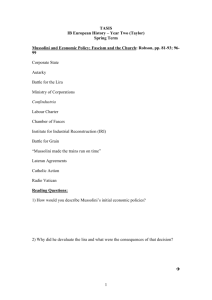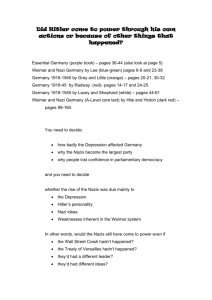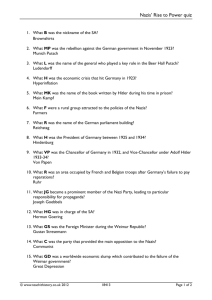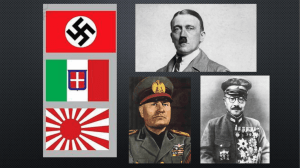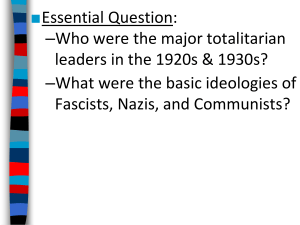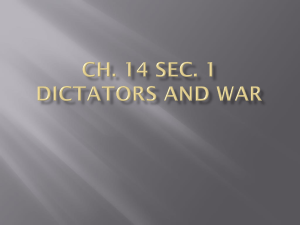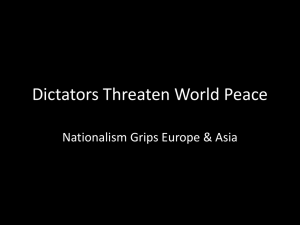AP Euro Chapter 26 Notes: Political Experiments of the 1920s
advertisement
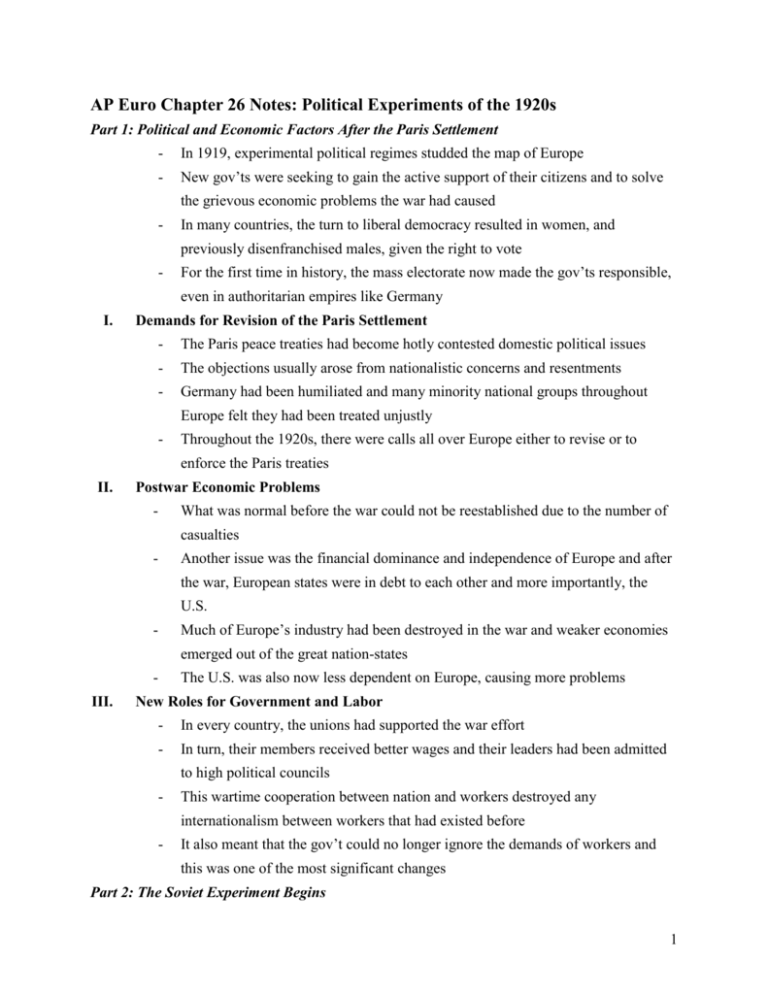
AP Euro Chapter 26 Notes: Political Experiments of the 1920s Part 1: Political and Economic Factors After the Paris Settlement - In 1919, experimental political regimes studded the map of Europe - New gov’ts were seeking to gain the active support of their citizens and to solve the grievous economic problems the war had caused - In many countries, the turn to liberal democracy resulted in women, and previously disenfranchised males, given the right to vote - For the first time in history, the mass electorate now made the gov’ts responsible, even in authoritarian empires like Germany I. Demands for Revision of the Paris Settlement - The Paris peace treaties had become hotly contested domestic political issues - The objections usually arose from nationalistic concerns and resentments - Germany had been humiliated and many minority national groups throughout Europe felt they had been treated unjustly - Throughout the 1920s, there were calls all over Europe either to revise or to enforce the Paris treaties II. Postwar Economic Problems - What was normal before the war could not be reestablished due to the number of casualties - Another issue was the financial dominance and independence of Europe and after the war, European states were in debt to each other and more importantly, the U.S. - Much of Europe’s industry had been destroyed in the war and weaker economies emerged out of the great nation-states III. The U.S. was also now less dependent on Europe, causing more problems New Roles for Government and Labor - In every country, the unions had supported the war effort - In turn, their members received better wages and their leaders had been admitted to high political councils - This wartime cooperation between nation and workers destroyed any internationalism between workers that had existed before - It also meant that the gov’t could no longer ignore the demands of workers and this was one of the most significant changes Part 2: The Soviet Experiment Begins 1 - The consolidation of the Bolshevik revolution in Russia and the formation of the U.S.S.R. (Soviet Union of Socialist Republics) was the single most transforming new element of post WWI Europe - The Soviet Union eventually constituted the most extensive and durable of all the 20th century authoritarian gov’ts that came to power after WWI - The Communist Party of the Soviet Union retained power from 1917 to 1991 and throughout the reign, communists sought to export their ideologies and policies I. War Communism - The Red Army, under the direction of Trotsky, suppressed internal and foreign military opposition to the new gov’t - The military threat allowed the Bolsheviks to pursue authoritarian policies and w/in months, a new secret police, known as the Cheka, appeared - Under the economic policy of war communism, the revolutionary gov’t confiscated and ran the banks, the transport system, and heavy industry - All major decisions flowed from the top in a nondemocratic manner - The state seized grain from the peasants to feed the army and the workers in the cities - The fact of the civil war allowed the Bolsheviks to suppress resistance to this economic policy - Throughout the period of the civil war, the gov’t repressed all actual or potential sources of opposition II. The Red Army eventually crushed the rebellion w/ grave loss of life The New Economic Policy - Under these difficult conditions, Lenin made a strategic defeat and outlined his New Economic Policy (NEP) following continued peasant resistance to grain requisition - Lenin would allow private enterprise, and peasants could farm for profit - The NEP was in line w/ Lenin’s conviction that the peasants were needed for a successful revolution but the NEP was not entirely successful since there really wasn’t anything to buy at this point III. Stalin Versus Trotsky - The NEP had caused disputes within the Politburo, the governing committee of the Communist Party 2 - Some members considered the partial return to capitalism a betrayal of Marxist principles - In 1922, Lenin suffered a stroke and in 1924, he died, leaving a power vacuum - Two factions emerged: one was led by Leon Trotsky and the other by Joseph Stalin, who had become general secretary in 1922 1. Trotsky’s Position - The issue between the two factions was power w/in the party, but the struggle was fought out over the question of Russia’s path toward industrialization and the future of the communist movement - Trotsky urged rapid industrialization financed through farm production - He believed agriculture should be collectivized and that other revolutions were needed elsewhere - He also advocated open criticism of the gov’t 2. Stalin’s Rise - Stalin was much less intellectual and internationalist than other Bolshevik leaders - He was more brutal and his handling of many national groups had shocked Lenin - Stalin amassed power through being the party’s general secretary and he gained a mastery of party structure, which helped him gain the support of the party’s lower levels - During the mid-1920s, a Communist Party faction known as the right wing opposed Trotsky - Its chief voice was that of Nikolai Bukharin, the editor of Pravda (Truth), the official party newspaper - The right wing pressed for the continuation of Lenin’s NEP - Stalin manipulated these intraparty rivalries and supported Bukharin’s position on the economy - He enunciated his policy of “socialism in one country” which meant that Russia alone could achieve socialism and eventually drove Trotsky out IV. The Third International - The Bolshevik revolution was a transforming event for the history of socialism as well as for Russia and international affairs - The event had stunned West European socialists, who did not respect the Bolsheviks - Many of these socialists regarded the Bolsheviks as enemies 3 - To establish themselves as the international leaders of Marxism, the Bolsheviks founded the Third International, known as the Comintern - The Comintern worked to make the Bolshevik model of socialism the rule for all socialist parties outside the Soviet Union - In 1920, the Comintern imposed its Twenty-one Conditions on any socialist party that wished to join it, which basically emphasized Bolshevik policy - The decision whether to adopt these conditions split every major European socialist party V. The policies of the Comintern affected the rise of the fascists and Nazis in Europe Women and the Family in the Early Soviet Union - Communists assumed that the traditional family embodied middle-class capitalist views - This outlook led to utopian projections of what the life of women and the family would resemble under socialism - Alexandra Kollontai, a utopian writer, stressed a new kind of family that would liberate both women and men VI. Few people in the Soviet Union agreed w/ her but her views became well known Family Legislation from Reform to Repression - After 1917, the Bolsheviks began issuing laws that affected women in a positive way - All of these measures were enacted to create a socialist society - However, the problems following the civil war disrupted family life in a major way, w/ an increase in violence and less births - Women could become leaders in the party in the 1920s but still as a whole experienced discrimination Part 3: The Fascist Experiment in Italy - Italy witnessed the first authoritarian political experiment: __________________________________________________________________ - From the Italian fascist movement of Benito Mussolini came the general terms fascist, and fascism, frequently used to describe a number of right-wing dictatorships that arose between the wars 4 - Most scholars agree that fascist gov’ts were antidemocratic, anti-Marxist, antiparliamentary, and: __________________________________________________________________ - The fascist regimes rejected the political: __________________________________________________________________ - Fascists wanted to overcome the class conflict of Marxism and the party conflict of liberalism by uniting the various groups and classes w/in the nation to achieve great national purposes - Mussolini became a model since he: __________________________________________________________________ - It is often forgotten the enormous impact he made on politics in the 1920s I. The Rise of Mussolini - The Italian Fasci di Combattimento, or “Bands of Combat” was founded in: __________________________________________________________________ - They felt that the Paris conference had cheated Italy of the hard-won fruits of labor and they feared the spread of socialism - Mussolini was the leader and early on, was associated w/: __________________________________________________________________ - He believed nationalism would turn Italy into a strong united Italy, but he changed his political ideas as it suited him 1. Postwar Italian Political Turmoil - Italian nationalists felt Italy had not been treated as a: __________________________________________________________________ - Extreme nationalist writer Gabriele D’Annunzio helped to seize Fiume w/ some patriotic Italians - He lost to the Italian army but he showed how: __________________________________________________________________ - Between 1919 and 1921, Italy had internal social turmoil as industrial strikes were common and peasants seized land - The gov’t seemed incapable: __________________________________________ 2. Early Fascist Organization - Mussolini was uncertain of the political winds and sided w/ the: __________________________________________________________________ 5 - He was also coming to see any social group pursuing its own goals as undermining national purposes and unity - He took direct action in the face of gov’t inaction and formed: __________________________________________________________________ - By 1922, they controlled the local gov’t in Northern Italy 3. March on Rome - In 1921, voters sent Mussolini and 34 of: __________________________________________________________________ - The fascist movement now had hundreds of thousands of supporters and in October 1922, the fascists, dressed in their black shirts, began a march on Rome - This Black Shirt March succeeded b/c King Victor: __________________________________________________________________ - On October 29, the king asked Mussolini to become prime minister and he became leader of the gov’t, technically legally II. The Fascists in Power 1. Repression of Opposition - The fascists changed election laws which dissolved all: __________________________________________________________________ - By the close of 1926, Mussolini had transformed Italy into a single-party, dictatorial state - Fascists were put in charge of the police force: __________________________________________________________________ - Thanks to propaganda, a cult of the personality surrounded Mussolini and crowds really began to like and admire him 2. Accord with the Vatican - One of Mussolini’s smart decisions was the Lateran Accord of February 1929, w/: __________________________________________________________________ - The agreement recognized the pope as the temporal ruler of Vatican City - The Italian gov’t agreed to pay an indemnity to the: __________________________________________________________________ - The state recognized Catholicism as the official religion, exempted church property from taxes, and other policies, which helped bring respectability to Mussolini’s regime 3. Motherhood for the Nation in Fascist Italy 6 - Fascist policy encourage Italian women to have more children: __________________________________________________________________ - Italian mothers were expected to see that their children attended fascist school programs - However, women still made up 25% of the nation’s work: __________________________________________________________________ - In 1938, the gov’t limited the number of women employees to no more than 10% and these policies helped to degrade women’s work even more Part 4: Joyless Victors I. France: The Search for Security - At the close of WWI, the French voters elected a conservative: __________________________________________________________________ - The conservatives believed that Clemenceau had failed to be harder on the losing nations at the peace conference and also failed to establish a separate Rhineland state - The deputies wanted to achieve: _______________________________________ - The gov’ts changed frequently and between 1918 and 1933, 27 cabinets took office in France 1. New Alliances - France took its role as the leading European: __________________________________________________________________ - The French plan was to keep Germany weak and to build a system of eastern alliances to replace the alliance w/ Russia - In 1920 and 1921, Czechoslovakia, Romania, and: __________________________________________________________________ - This new system was very weak and most of the nations were concerned about Russia, not Germany and it also made Germany and Russia signed a treaty of their own 2. Quest for Reparations - In 1923, the Allies, and mainly France: __________________________________________________________________ - Raymond Poincaré, France’s nationalistic prime minister, decided to force the Germans to comply by sending troops to occupy the Ruhr, Germany’s mining and manufacturing district 7 - The German gov’t ordered passive resistance w/: __________________________________________________________________ - The French decision was costly as it alienated Britain, who had no part in it, and created hyperinflation in Germany II. Great Britain: Economic Confusion - WWI changed British politics: _________________________________________ - By 1918, Parliament expanded to include all men aged 21 and all women aged 30 - By December 1918, Parliament had more Conservatives than Liberals, and David Lloyd George: __________________________________________________________________ - There were major economic problems in Britain as there was no genuine postwar recovery and unemployment stayed near 10% 1. The First Labour Government - In October 1922, Conservatives replaced Lloyd George w/ Andrew: __________________________________________________________________ - Stanley Baldwin soon replaced Law and tried to impose protective tariffs, but the voters rejected that policy in 1923 - In that election, the Labour Party gained power again: __________________________________________________________________ - The Labour Party was socialistic, but democratic and nonrevolutionary and MacDonald tried more for social reform rather than economic reform 2. The General Strike of 1926 - The stagnant economy was uppermost in the public mind and: __________________________________________________________________ - The Conservative gov’t in 1925 tried to return to the gold standard, but made conversion rates too high, and in effect, raised British prices - British management then cut wages to be: __________________________________________________________________ - It started w/ coal miners but soon after, other workers joined in but was mainly ineffective due to high rates of unemployment but Baldwin still tried to reconcile the gov’t and labor 3. Empire - The aid the dominions, mainly Canada and Australia: __________________________________________________________________ 8 - The idea of self-determination as applied to Europe filtered into imperial relationships - In India, the Congress Party, led by Mohandas Gandhi: __________________________________________________________________ - Moreover, during the 1920s, the gov’t in India achieved the right to impose tariffs to protect its industry rather than for the advantage of British manufacturers 4. Ireland - In 1914, the Irish Home Rule Bill had passed Parliament: __________________________________________________________________ - Irish nationalists didn’t want to wait and on Easter Monday in April 1916, a nationalist uprising occurred in Dublin - The British suppressed it but then executed the leaders: __________________________________________________________________ - Leadership of the nationalistic cause shifted from the Irish Party to the extremist Sinn Fein or “Ourselves Alone” - In the election of 1918, Sinn Fein won all but four: __________________________________________________________________ - On January 21, 1919, they declared Irish independence, and the military wing of Sinn Fein became the Irish Republican Army (IRA) - A guerilla war broke out between the IRA and the British army: __________________________________________________________________ - In late 1921, the two gov’ts began secret negotiations and in December, the Irish Free State came into being - Six counties remained a part of the: __________________________________________________________________ Part 5: Trials of the Successor States in Eastern Europe I. Economic and Ethnic Pressures - All the new states created by WWI faced: __________________________________________________________________ - Only Czechoslovakia was financially independent, and most of them depended on foreign loans to finance economic development - Nationalistic antagonisms often prevented these states from: __________________________________________________________________ 9 - The collapse of the old empires in eastern Europe allowed ethnic groups to pursue their nationalistic goals and were unwilling to make compromises II. Poland: Democracy to Military Rule - An independent Poland had been one of Wilson’s Fourteen Points: __________________________________________________________________ - Large Ukrainian, Jewish, Lithuanian, and German minorities distrusted the Polish gov’t and resented the domination of Polish culture in their lives - The new Poland had been constructed from portions governed by Germany, Russia, and Austria for over a: __________________________________________________________________ III. Czechoslovakia: A Viable Democratic Experiment - Czechoslovakia possessed a strong industrial base, a substantial middle class: __________________________________________________________________ - Thomas Masaryk led the country and he fair and had integrity, which allowed the country to have a chance of becoming a viable, modern nation-state - However, there were tensions between the Czechs and Slovaks: __________________________________________________________________ IV. Hungary: Turn to Authoritarianism - Hungary gained a long-desired split from Austria in losing: __________________________________________________________________ - In 1919, Bela Kun, a communist, established a short-lived Hungarian Soviet Republic, but the Allies removed the communist danger - Hungary also resented the territory Hungary had lost during the peace settlement, and the economy was: __________________________________________________________________ V. Austria: Political Turmoil and Nazi Occupation - Viable economic life was almost impossible and the: __________________________________________________________________ - Throughout the 1920s, the leftist Social Democrats and the conservative Christian Socialists contended for power - Both groups employed small armies to terrorize: __________________________________________________________________ 10 - In 1933, the Christian Socialist Engelbert Dollfuss became chancellor and tried to keep the Nazis out of power but eventually failed and the Nazis occupied Austria in 1938 VI. Southeastern Europe: Royal Dictatorships - Yugoslavia had been founded by the Corfu Agreement of 1917: __________________________________________________________________ - The Serbs dominated the gov’t and were opposed by the Croats, and the two groups clashed violently - Bosnia-Herzegovina had a significant Muslim population: __________________________________________________________________ - The clash of nationalities led to a royal dictatorship in 1929 under King Alexander I Part 6: The Weimar Republic in Germany - The German Weimar Republic was born amid the defeat of the imperial army, the revolution of 1918 against the: __________________________________________________________________ - Its name came from the city of Weimar, where its constitution was written in August 1919 - The republic was associated w/ the national: __________________________________________________________________ - Many Germans wanted to revise the peace treaty and b/c of various degrees of loyalty to the constitution, the Weimar Republic was always in danger I. Constitutional Flaws - The Weimar constitution was a: _______________________________________ - It guaranteed civil liberties, and provided for direct election by universal suffrage in the Reichstag - It contained major flaws however, such as allowing its liberal institutions to be: __________________________________________________________________ - This system made it easy for small parties to gain seats in the Reichstag, and also the president could rule by decree in emergencies II. Lack of Broad Popular Support - Many political figures still favored a constitutional monarchy, and many: __________________________________________________________________ 11 - Many Germans wanted to revise the peace treaty and modify the system of gov’t, and the early years of the republic only reinforced these sentiments - In March 1920, the right-wing Kapp Putsch, or “armed insurrection” erupted in Berlin, but failed, but still haunted: __________________________________________________________________ III. Invasion of the Ruhr and Inflation - The value of German currency fell due to deficit spending and a: __________________________________________________________________ - The French invasion of the Ruhr in 1923 produced hyperinflation, since the gov’t had no workers producing goods and the gov’t also kept printing more money - Money was literally worth: ___________________________________________ - The great inflation was disastrous for Germans as savings were wiped out, homes lost, and made Germans wish for security IV. Hitler’s Early Career - In late 1923, Adolph Hitler made: ______________________________________ - In his early years, he had come to absorb much of the German nationalism floating around and was extremely anti-Semitic and anti-Marxist - WWI gave him his first sense of purpose as he rose to: __________________________________________________________________ - He became associated w/ a small nationalistic, anti-Semitic political party, which in 1920 adopted the name of National Socialist German Workers’ Party, better known as the Nazis - They began to parade under a red and white banner w/ a black swastika, and its platform called the Twenty-Five Points called for the repudiation of the Versailles treaty, unification: __________________________________________________________________ - The Nazis redefined the term socialist to suggest a nationalistic outlook, and had nothing to do w/ traditional German socialism - The socialism the Nazis had in mind was the subordination of all economic enterprise to the welfare of: __________________________________________________________________ - The Nazis tailored their message to various: __________________________________________________________________ 12 - The storm troopers, or SA (Sturmabteilung) were organized under Captain Ernst Roehm - The SA was a paramilitary group that provided its members w/ food and uniforms: __________________________________________________________________ - The SA were the chief instrument for Nazi terror and intimidation before the party controlled the gov’t, and was a sign of the potential for violence in the Weimar Republic - The social and economic turmoil following the French occupation of the Ruhr provided the Nazis w/ an: __________________________________________________________________ - As Hitler established his dominance in the party, he clearly had the model of Mussolini in mind, as both used similar tactics - By late 1923, Hitler used Mussolini’s March on: __________________________________________________________________ - On November 9, 1923, Hitler and a band of followers, accompanied by General Ludendorff, attempted a putsch from a beer hall in Munich, which failed - Hitler was arrested and tried for treason and sentenced to five years in prison, where he wrote Mein Kampf: __________________________________________________________________ - The natural targets of implementing his racial outlooks and foreign policy would be Jews, the successor states in eastern Europe, the USSR, and any groups that opposed Hitler’s vision - Hitler reached two decisions during his imprisonment: first, he saw himself as the leader who would make Germany: __________________________________________________________________ V. The Stresemann Years - Gustav Stresemann was chancellor from August to November 1923, and was: __________________________________________________________________ - He introduced a new German currency, moved against challenges from the left and right, and exercised considerable influence over the affairs of the republic - In 1924, the Weimar Republic and the Allies agreed to the Dawes Plan, which would allow the Germans to repay: __________________________________________________________________ 13 VI. Locarno - The Locarno Agreements of 1925 said that France and: __________________________________________________________________ - Also, Britain and Italy agreed to intervene against whichever side violated the frontier or if Germany sent troops into the Rhineland - Locarno pleased everyone and it brought a spirit of new hope to Europe, and also in 1928, the Kellogg-Briand Pact was: __________________________________________________________________ - The joy and optimism was not justified and: __________________________________________________________________ __________________________________________________________________ - The eastern question was also not settled, and Germany continued its connections w/ the USSR - In Germany, many people continued to reject the: __________________________________________________________________ - Germans continued to be against reparations and this showed how far Germany was from accepting their situation - The Great Depression and new leaders: __________________________________________________________________ 14

